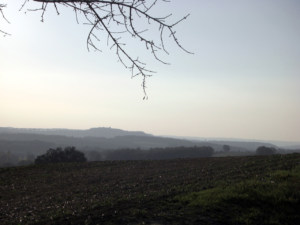The origins of the thirteenth century fortified town

.
The photograph above shows a distant and misty view of Castelnau de Montmiral. It is intended to give a sense of the veil of time that separates us from the year 1222, when the neighbouring fortress towns of Castelnau de Montmiral and Cordes sur Ciel were founded by the young Count Raymond VII of Toulouse, during a lull in the fast failing fortunes of his still very powerful family. He was taking advantage of an unexpected turn of events to reassert and buttress his family’s claim to a long-disputed region north of the river Tarn.
The Cathars
The origin of Raymond’s troubles had been an alarming increase in influence of a religious sect known as the Cathars and the attempts by the Roman Catholic Church to eradicate its adherents. The result was a crusade instigated by the Pope and undertaken by ambitious and land hungry knights from the north, which was to destabilise the political situation and, eventually, to facilitate the effective takeover of the county of Toulouse by the Capetian kings of France.
The meaning of the words “castelnau” and “bastide”
The word “castelnau” signifies a “new fortress town”. In the case of Castelnau de Montmiral, a hilltop location and imposing ramparts were needed for strictly military reasons. They were needed to defend territories north of the river Tarn against the threat of the formerly crusading knights who had by now established themselves to the south of the river, as powerful and potentially aggressive landowners.
The building of such fortress towns were banned after 1229 by the treaty which brought hostilities to a close. This was the “Treaty of Meaux” whose main signatories were Raymond VII of Toulouse and King Louis XIII of France. While the treaty’s primary purpose was to agree a land settlement, it also paved the way for the building of a network of market towns in S.W. France. These came to be known as “bastides”. The first of them was founded soon after the Treaty of Meaux, and the last, some 100 years later. Experiments, first in England and then in northern France (where the new towns were called “villeneuves”), had shown the value of such market towns as both engines of economic growth and of increased baronial control.
Whereas Castelnau de Montmiral and other fortress towns were built to repel attacking armies, the “bastides” were planned with their function as market towns in mind. In particular, the Treaty of Meaux decreed that their outer walls were only to be thick enough to keep out small groups of bandits.
One conclusion that can be drawn from the above is that, according to the proper definition, none of the towns in the so called “circuit des bastides” are “bastides” (see “Local Attractions and Links” page). Another is that despite beinf describes as “un des plus beaux villages de France”, Castelnau de Montmiral is a town.
The Hundred Year’s war
In the following century, which saw the start of the Hundred Years War and the passage of marauding bands of soldiers led by the Black Prince and others. During these unsettled years, Castelnau de Montmiral came into the possession of the Counts of Armagnac. This was a small step in a process of land acquisition that led, by the early 15th century, to the Armagnacs becoming one of the two most powerful baronial families in France. It was their rivalry with the other family, the Counts of Burgundy, that gave the English, under Henry V, the chance to divide and conquer at the Battle of Agincourt. It was the catastrophic failure of the Armagnacs at that battle that eventually led to them being ousted from power and dispossessed of their titles and lands. The last of their line was pensioned off, out of harm’s way, in Castelnau de Montmiral and, on his death, he left to the town’s people the jewelled reliquary cross that can be found in the church today.
Prosperity arrives
During the 15th century French Wars of Religion, Castelnau de Montmiral remained a Catholic stronghold in a largely Protestant region. By the end of the century, the townspeople were sharing in the widespread renewal of prosperity that was to underpin the country’s rise to European pre-eminence under Louis XIV, the Sun King. They were embarking upon a rebuilding programme which was finally to transform Castelnau de Montmiral from being a formidable fortress town into a more accessible commercial centre. An important part of the process was the building of the esplanade situated on the north-east side of the town, which more than halved the height of the steep escarpment that had been such an important part of the defences of the medieval fortress town. Work on it was started in 1598 and completed just in time for the visit of King Louis XIII and his unruly retinue, who were on their way to suppress a last flaring up of Protestant revolt in 1621. One of the houses overlooking the esplanade is now the Painting School.